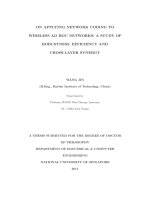en CCNAS v11 ch02 securing network devices
Bạn đang xem bản rút gọn của tài liệu. Xem và tải ngay bản đầy đủ của tài liệu tại đây (1.86 MB, 179 trang )
Securing Network Devices
© 2012 Cisco and/or its affiliates. All rights reserved.
1
Cisco Integrated Services Routers G2
•
Cisco has a new Series of 2nd Generation Routers.
•
G2 ISRs have integrated Gigabit Ethernet interfaces.
/>
© 2012 Cisco and/or its affiliates. All rights reserved.
2
Enforcing Perimeter Security Policy
•
Routers are used to secure the network perimeter.
•
Scenario 1:
–
•
The router protects the LAN.
Router 1 (R1)
LAN 1
Internet
192.168.2.0
Scenario 1
Scenario 2:
–
The router screens traffic before a firewall (PIX/ASA).
R1
Firewall
Internet
•
LAN 1
192.168.2.0
Scenario 3:
–
The zone directly connected to the firewall is called a
DMZ.
–
Internet-accessible servers are located in the DMZ.
Scenario 2
R1
Firewall
R2
LAN 1
Internet
192.168.2.0
DMZ
Scenario 3
© 2012 Cisco and/or its affiliates. All rights reserved.
3
Three Areas of Router Security
•
Physical security
–
–
Secure infrastructure equipment in a locked room that:
•
Is accessible only to authorized personnel.
•
Is free of electrostatic or magnetic interference.
•
Has fire suppression.
•
Has controls for temperature and humidity.
Install an uninterruptible power supply (UPS) and keep spare components available to reduce the possibility of a DoS attack from
power loss to the building.
© 2012 Cisco and/or its affiliates. All rights reserved.
4
Three Areas of Router Security
•
Operating system
–
Configure the router with the maximum amount of memory possible.
•
Helps protect it from some DoS attacks.
–
Use the latest stable version of the operating system that meets the feature requirements of the network.
–
Keep a secure copy of the router operating system image and router configuration file as a backup.
© 2012 Cisco and/or its affiliates. All rights reserved.
5
Three Areas of Router Security
•
Router hardening
–
Secure administrative control to ensure that only authorized personnel have access and that their level of access is controlled.
–
Disable unused ports and interfaces to reduce the number of ways a device can be accessed.
–
Disable unnecessary services that can be used by an attacker to gather information or for exploitation.
R1
© 2012 Cisco and/or its affiliates. All rights reserved.
6
Secure Administrative Access
•
Restrict device accessibility
–
•
Log and account for all access
–
•
Limit the accessible ports, restrict the permitted communicators, and restrict the permitted methods of access.
For auditing purposes, record anyone who accesses a device, including what occurs and when.
Authenticate access
–
Ensure that access is granted only to authenticated users, groups, and services.
–
Limit the number of failed login attempts and the time between logins.
© 2012 Cisco and/or its affiliates. All rights reserved.
7
Secure Administrative Access
•
Authorize actions
–
•
Present Legal Notification
–
•
Restrict the actions and views permitted by any particular user, group, or service.
Display a legal notice, developed in conjunction with company legal counsel, for interactive sessions.
Ensure the confidentiality of data
–
Protect locally stored sensitive data from viewing and copying.
–
Consider the vulnerability of data in transit over a communication channel to sniffing, session hijacking, and man-in-the-middle (MITM)
attacks.
© 2012 Cisco and/or its affiliates. All rights reserved.
8
Secure Administrative Access
© 2012 Cisco and/or its affiliates. All rights reserved.
9
Cisco Router Passwords
•
All routers need a locally configured password for privileged access and other access.
R1(config)# enable secret cisco
R1(config)# line vty 0 4
R1(config)# line aux 0
R1(config-line)# password cisco
R1(config-line)# password cisco
R1(config-line)# login
R1(config-line)# login
R1
R1(config)# line con 0
R1(config-line)# password cisco
R1(config-line)# login
© 2012 Cisco and/or its affiliates. All rights reserved.
10
Cisco Router Passwords
•
•
To steal passwords, attackers:
–
Shoulder surf.
–
Guess passwords based on the user's personal information.
–
Sniff TFTP packets containing plaintext configuration files.
–
Use readily available brute force attack tools such as L0phtCrack or Cain & Abel.
Strong passwords are the primary defense against unauthorized access to a router!
© 2012 Cisco and/or its affiliates. All rights reserved.
11
Strong Passwords
•
Passwords should NOT use dictionary words
–
•
Dictionary words are vulnerable to dictionary attacks.
Passwords may include the following:
–
Any alphanumeric character.
–
A mix of uppercase and lowercase characters.
–
Symbols and spaces.
–
A combination of letters, numbers, and symbols.
Note:
–
Password-leading spaces are ignored, but all spaces after the first character are NOT ignored.
© 2012 Cisco and/or its affiliates. All rights reserved.
12
Strong Passwords
•
•
Change passwords frequently.
–
Implement a policy defining when and how often the passwords must be changed.
–
Limits the window of opportunity for a hacker to crack a password.
–
Limits the window of exposure after a password has been cracked.
Local rules can make passwords even safer.
© 2012 Cisco and/or its affiliates. All rights reserved.
13
Passphrases
•
•
One well known method of creating strong passwords is to use passphrases.
–
Basically a sentence / phrase that serves as a more secure password.
–
Use a sentence, quote from a book, or song lyric that you can easily remember as the basis of the strong password or pass phrase.
For example:
–
“My favorite spy is James Bond 007.”
= MfsiJB007.
–
“It was the best of times, it was the worst of times.”
= Iwtbotiwtwot.
–
“Fly me to the moon. And let me play among the stars.”
© 2012 Cisco and/or its affiliates. All rights reserved.
= FmttmAlmpats.
14
Password Protection Guidelines
•
•
Use a password length of 10 or more characters. The longer, the better.
•
Avoid passwords based on repetition, dictionary words, letter or number sequences, usernames, relative or pet
names, biographical information, such as birthdates, ID numbers, ancestor names, or other easily identifiable
pieces of information.
•
Deliberately misspell a password.
Make passwords complex by including a mix of UPPERCASE and lowercase letters, numbers, symbols, and
spaces.
–
For example, Smith = Smyth = 5mYth or Security = 5ecur1ty.
•
Change passwords often so if a password is unknowingly compromised, the window of opportunity for the
attacker to use the password is limited.
•
Do not write passwords down and leave them in obvious places such as on the desk or monitor.
© 2012 Cisco and/or its affiliates. All rights reserved.
15
Cisco Router Passwords
•
To increase the security of passwords, the following Cisco IOS commands should be utilized:
–
Enforce minimum password length: security passwords min-length.
–
Disable unattended connections: exec-timeout.
–
Encrypt config file passwords: service password-encryption.
© 2012 Cisco and/or its affiliates. All rights reserved.
16
Enforce Minimum Password Lengths
•
•
Make passwords lengthy.
–
IOS 12.3 and later passwords can be 0 to 16 characters in length.
–
The best practice is to have a minimum of 10 characters.
To enforce the minimum length use the global command:
–
•
The command affects all “new” router passwords.
–
•
security passwords min-length length
Existing router passwords are unaffected.
Any attempt to create a new password that is less than the specified length fails and results in an “Password too
short” error message.
© 2012 Cisco and/or its affiliates. All rights reserved.
17
Disable Unattended Connections
•
•
By default, an administrative interface stays active and logged in for 10 minutes after the last session activity.
–
After that, the interface times out and logs out of the session.
The timer can be adjusted using the exec-timeout command in line configuration mode for each of the line
types that are used.
–
exec-timeout minutes seconds
Note:
–
exec-timeout 0 0 means that there will be no timeout and the session will stay active for an unlimited time.
•
•
•
Great for Labs …
Bad in production networks!
Never set the value to 0!
© 2012 Cisco and/or its affiliates. All rights reserved.
18
Disable Unattended Connections
•
Default time is 10 minutes.
•
Terminates an unattended connection (console or vty).
•
Provides additional level of security if an administrator walks away from an active console session.
Router(config-line)#
exec-timeout minutes [seconds]
–
To terminate an unattended console connection after 3 minutes and 30 seconds:
Sudbury(config)# line console 0
Sudbury(config-line)# exec-timeout 3 30
–
To disable the exec process on the line:
Sudbury(config)# line aux 0
Sudbury(config-line)# no exec-timeout
© 2012 Cisco and/or its affiliates. All rights reserved.
19
Encrypt All Passwords
•
Encrypt all passwords in the router configuration file.
Router(config)#
service password-encryption
R1(config)# service password-encryption
R1(config)# exit
R1# show running-config
enable password 7 06020026144A061E
!
line con 0
password 7 094F471A1A0A
login
!
line aux 0
password 7 01100F175804575D72
login
line vty 0 4
password 7 03095A0F034F38435B49150A1819
login
© 2012 Cisco and/or its affiliates. All rights reserved.
20
Securing Local Database Passwords
•
Secure the local database passwords.
–
Traditional user configuration with plaintext password.
username name password {[0] password | 7 hidden-password}
–
Use MD5 hashing for strong password protection.
–
More secure than the type 7 encryption.
username name secret {[0] password | encrypted-secret}
© 2012 Cisco and/or its affiliates. All rights reserved.
21
Securing Local Database Passwords
R1# conf t
R1(config)# username JR-ADMIN password letmein
% Password too short - must be at least 10 characters. Password configuration failed
R1(config)# username JR-ADMIN password cisco12345
R1(config)# username ADMIN secret cisco54321
R1(config)# line con 0
R1(config-line)# login local
R1# show run | include username
username JR-ADMIN password 7 060506324F41584B564347
username ADMIN secret 5 $1$G3oQ$hEvsd5iz76WJuSJvtzs8I0
R1#
R1 con0 is now available
Press RETURN to get started.
User Access Verification
Username: ADMIN
Password:
R1>
© 2012 Cisco and/or its affiliates. All rights reserved.
22
Secure Virtual Logins
•
To improve security for virtual login connections, the login
process should be configured with specific parameters:
–
Implement delays between successive login attempts.
–
Enable login shutdown if DoS attacks are suspected.
–
Welcome
Welcome to
to SPAN
SPAN Engineering
Engineering
User
User Access
Access Verification
Verification
Generate system logging messages for login detection.
Password:
Password: cisco
cisco
Password:
Password: cisco1
cisco1
Password:
Password: cisco12
cisco12
Password:
Password: cisco123
cisco123
Password:
Password: cisco1234
cisco1234
© 2012 Cisco and/or its affiliates. All rights reserved.
23
Disable Login for Excessive Attempts
R1# configure terminal
R1(config)# username ADMIN secret cisco54321
R1(config)# line vty 0 4
R1(config-line)# login local
R1(config)# exit
R1(config)# login block-for 120 attempts 5 within 60
R1(config)# ip access-list standard PERMIT-ADMIN
R1(config-std-nacl)# remark Permit only Administrative hosts
R1(config-std-nacl)# permit 192.168.10.10
R1(config-std-nacl)# permit 192.168.11.10
R1(config-std-nacl)# exit
R1(config)# login quiet-mode access-class PERMIT-ADMIN
R1(config)# login delay 10
R1(config)# login on-success log
R1(config)# login on-failure log
R1(config)# exit
•
In this sample config, if more than 5 login failures occur within 60 seconds, then all logins will be disabled for 120 seconds.
–
–
•
This command must be issued before any other login command can be used.
The command also helps provide DoS detection and prevention.
The PERMIT-ADMIN commands exempt administrative stations from the disabled login.
–
If not configured, all login requests will be denied during the Quiet-Mode.
© 2012 Cisco and/or its affiliates. All rights reserved.
24
Verify Login Security
R1# show login
A login delay of 10 seconds is applied.
Quiet-Mode access list PERMIT-ADMIN is applied.
Router enabled to watch for login Attacks.
If more than 5 login failures occur in 60 seconds or less,
logins will be disabled for 120 seconds.
Router presently in Normal-Mode.
Current Watch Window
Time remaining: 5 seconds.
Login failures for current window: 4.
Total login failures: 4.
•
In this example, the login block-for command was configured to block login hosts for 120 seconds if more than 5 login
requests fail within 60 seconds.
© 2012 Cisco and/or its affiliates. All rights reserved.
25









